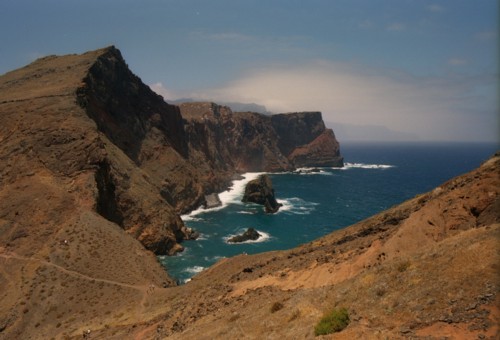

Introduction
My name is Christopher and my partner's called Anne. We live in Stockport, (near Manchester), England. We gain a lot of pleasure from walking and discovering new landscapes, last year we spent two weeks in Madeira (August 2000). We had a wonderful holiday and would like to share our experiences with you.
Walk or relax?
We do enjoy walking but there are often moments when we wonder why we work so hard. We decided it would be nice to spend a day by the pool or on a beach. There are so many beautiful places to visit on Madeira - you can discover something new every day! You don't need to tire yourself out walking to enjoy Madeira - why not use the local transport to take you to your destination, where you can relax.
Levada (Aqueduct)
Madeira's major walking attraction is the vast network of Levadas built by the islands early settlers, centuries ago, to supply water to irrigate the cultivated land of the lower slopes. Although this system is not unique to Madeira, it is the maintenance paths that run alongside that provide access for walking.
There are many high mountain springs and so the Levada was designed to carry the water vast distances via channels carved into the landscape. There are over 2100 km (1300 miles) of channels and 40 km (25 miles) of tunnels. The settlers used contract labour (often slave or convict) to carve out the narrow watercourses. Many lost their lives to bring water and power to the island.
Many of the levadas (by 1900 about 200, covering 1000 km / 620 miles) were privately owned and the water was often unfairly distributed. By the mid 1930's only 60% of arable land was being cultivated and only half of that received irrigation.
There was plenty of water available for both irrigation and power. The central mountains capture clouds propelled by the prevailing northerly winds. In the north, up to 2 m (80 inches) of rain can fall in twelve months. The rain water fills the islands natural springs, overflowing, it finds a way to reach the sea where it eventually evaporates to form new cloud systems. Surplus water can be channelled to generate power and irrigate the land.
In 1939 the Portuguese government started to investigate implementation of a combined irrigation and hydroelectric system. The first of the new and wider levadas were carved out at 1000m (3300 feet) altitude, where there was a higher concentration of rainfall. The water was channelled and then piped to the power stations on the outer edges of arable land at altitudes around 600m (2000 feet). It was then re- channelled to the areas of irrigation and distributed by the levadeiro to supply individual landowners. Two of the most important projects were the Levada do Norte and the Levada dos Tornos, which took about 25 years to complete. 1970 marked the completion of most of the work that had been planned.
Walking Guides
It was due to my search of the Internet for information on Madeira that I discovered what I believe to be one of the best walking guides ever written.
I am not a lover of walking guide books and find that in most books the instructions are often vague (it's OK - the author knows the walk!) and padded out with interesting facts that don't help you find your way! This can be frustrating.
I highly recommend "Landscapes of Madeira, by Pat and John Underwood" Sunflower books ISBN 1-85691-200-0. Be sure to obtain the latest edition (now 7) although updates between editions are available from Sunflower for £1.00.
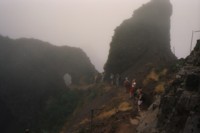
The book has been written specifically for car tours, walking and picnics. All maps are included, car tours and walks are illustrated with colour pictures and detailed easy to follow instructions that actually explain how to get to your destination. Even bus timetables are provided. There are several bus companies offering coverage of the entire island. This guide even provides a map showing where to get the bus in Funchal (see main town map page) and what colour bus you need. We based our entire holiday on this book. The only thing I will gain from recommending this book is the pleasure of knowing you will have a fantastic holiday - it is Madeira's bible.
I could not ask for more from a guidebook than Pat and John Underwood offer in their Sunflower guide and consider it essential but here are two other titles which could be of interest…
"Walking in Madeira, by Paddy Dillon" Cicerone Books ISBN 1-85284-334-9
A new title for 2001, I have used Paddy Dillon's guides before and this should be good. Includes 50 walks. Pocket sized guide, price about £12.00
"Madeira - a warm island walking guide" Discovery Walking guides
Pocket size folded map and instruction booklet in a fold up plastic wallet. Price is around £4.00. At that price well worth having a copy anyway!
Transport
Car Hire - We did not hire a car on the island but there seem to be plenty of companies offering hire. You will probably get the safest deal through your tour operator. I would not want to risk driving here, the Portuguese don't seem to care about being classed as the worst drivers in Europe. I can only say that I have never seen such chaos on the road before, in fact it is amusing because there are so many near misses - just when you think there is going to be a big argument, the drivers start laughing and waving hands! I would take a look before you book anything!
Bus Service - The busses operate in zones and you must familiarise yourself with the system. The bus information office can provide you with assistance. The information office is opposite the "Sao Lourenco Palace" on the Avenida do Mar (on the harbour front) and at the easterly end of the same road where it meets the "5 de Outubro" main carriageway from inland - see town plan (available from the Tourist Information).
Ask for the pre-paid ticket offers - they are much cheaper than paying cash on the bus. These are only available for Town Bus zones though. You can pay on the busses or purchase tickets from the associated ticket office once you locate them.
Do not be put off by the apparent complexity - The busses are very reliable and cheap. We had a fantastic holiday thanks to a superb bus service.
The bus companies use a bus painted in a specific colour so that you can identify them. For example, the busses that operate in the town are painted Orange (Horarios do Funchal bus company). The sunflower guidebook contains a map which shows you where to get the bus and what colour bus you need. This is incredibly useful, as the bus system is very cheap and can take you to most of the levada walks around the island, although the extreme western locations cannot be reached in a reasonable time to complete a walk. The conductors seem to know all the typical drop points for the various levadas - we were surprised.
Taxi - The taxis are very cheap but always agree a price before you climb in. You must be prepared to barter for the best price. This is common practice and the first price you are given will almost certainly reflect this, although it might seem cheap you should try to force the price down. Don't worry - it's all good fun! All the taxis are yellow Mercedes top range cars and very luxurious. You can hire a taxi for the full day and they will offer a price for this, about £60 when we visited the island (2000). The cars only operate in their own areas but they will actually return and collect you if you arrange this in advance. They proved reliable for us. If you have a holiday rep, ask if they have a favourite driver, it is often possible to get a special deal from drivers that have a lot of work put their way.
You will often find Taxis waiting outside hotels for potential fares. This can prove useful but take care as they often make the offer "I can take you to a nice levada walk". If you don't want to get lost stick to the guidebook!
Climate / Temperature
The temperature remained stable at 25 degrees centigrade throughout our holiday. We enquired of temperatures during winter months and a lower figure of 18 degrees was mentioned.
During our visit we noticed a characteristic pattern of cloud formation at midday. The mornings always seem to offer clear blue skies, which seem to become taken over by clouds quickly. If you intend to visit the high mountains you would be wise to make an early start. Always think about taking your photos early in the day when the skies are clear. I have been told of similar conditions in the Canary Islands at this time of year. We did not have any rain during our two-week holiday.
An important fact to note, due to your position relative to the equator there is almost no period of twilight near sunrise or sunset. Don't leave it late to return from a walk, it can become totally dark very quickly so be aware of current daylight hours before you set out.
Always carry and use a high protection factor sun cream - You should use at least a 25 UVA at first and you are taking a serious risk if you drop below 15. Carry a hat or clothing to cover up before you burn. I made the mistake of not using cream one afternoon when it became cloudy. My shoulder was very badly burnt despite exposure for a week previously. It took almost three months to heal and I still have the scar to help me remember my foolishness! I thought I was experienced enough to know better so take care.
Tourist Information Office
The office can be found on the "Avda Arriaga", this road is central and runs parallel (inland) to the harbour front road. If you find the "Sao Lourenco Palace" on the harbour front, when facing it, walk away from the sea along the road on its right side called "Zarco", turn first left on the busy "Avda Arriaga" and you will see the tourist office across the road before the gardens.
Ask for a free town map.
Web Cam
Take a look at the local web cams before your visit…
Shops
Take a good look around at all the shops. You can find everything you need to make up a picnic lunch. If you are self-catering then you won't have any problem shopping for your holiday.
We stayed on the outskirts of the town at Hotel Girrasol and if you head out past the "Reids Gardens" (twenty minute walk or frequent busses) you pass the Guinness bar (owned by the Hotel Crowne Plaza) then the supermarket complex on your left (bus stop here). If you walk down the steep road here you pass a wine shop on your right. This is well worth a visit - they have a superb collection of wines and spirits at reasonable prices. The supermarket is further down - turn right into the car park for the main entrance.
Almost opposite this steep road (bus stop) and across the busy main road road, is a small bakers / café where you can obtain wonderful home baked pies and sausage rolls suitable for picnic lunches.
Madeira Wine
Madeira wine is similar to Sherry. It is quite strong in alcohol and usually sweet although you can choose varying degrees of sweetness. Price varies greatly depending on the age and type, as you might expect with any wine.
I found that most shops and supermarkets stock three types based on three / five, ten and fifteen year vintage. The price range is around £4, £8 and £15 for 700-ml sizes respectively. I thought I would try the cheapest and was surprised at the quality. You can keep this wine for many years and it will continue to improve with age. The shops offer many gift type presentations containing miniatures, or smaller (300-ml) assorted types.
Specialist collectors can obtain vintage Madeira wines from years past - a wine bottled the year you were born for example. Prices vary depending on the performance of the vintage. There's a specialist supplier in Funchal if you are interested.
For everything you need to know about Madeira wine and history visit…
Day Trips
Our tour operator had a good choice of day trips and coach tours at reasonable prices. We managed to visit most of the popular places by bus and recommend this mode of transport.
There are two main trips available offering "West Tour" and "East Tour". We managed to see most of the east of the island using the busses. The west tour is well worthwhile. I expect most companies will offer a similar route / package so we can give you some idea of what to expect…
Leave Funchal and climb north west above Camara de Lobos where we were allowed to take photographs.
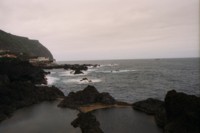
Continue to the highest sea cliff called Gabo Girao where you alight to look down (from behind a safe iron railing) a vertical drop of 580 m (1900 feet) to the turquoise sea below. We then drive on to Ribeira Brava where we stopped for about thirty minutes (toilets and refreshments) to shop. The coach then takes you up to the plateau called Paula da Serra where we were allowed to take a short walk for photographs.We continued back down to a restaurant at Port Moniz where a meal was provided (included in the tour) with wine. We returned to Funchal via the narrow coast road (don't look out of the bus if you suffer with vertigo) stopping briefly near Seixal to view a waterfall (free car wash) and superb views of the north coast towards Sao Vicente and back to Porto Moniz. The coach chooses the new fast road route back home.
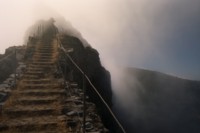
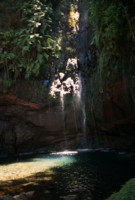
Three Peaks Walk and 25 Fontes -
We discovered that these walks were not possible to get to by bus and a taxi might prove expensive. Our holiday rep recommended a local company (they would only choose the safest) called "Nature Meetings".
They offer a selection of graded walks, transport to and from the walk, experienced guide, some include a very good packed lunch, use of rucksacks and walking stick (if you didn't take them) and also stopping at places of scenic beauty on route or a café.
For further information visit…
www.madeiralevadawalks.com and www.naturemeetings.com
Tour Operators Welcome Meeting
If you are invited to a welcome meeting do take advantage of this, you pay for this service so make good use of it by asking questions. I hope this report gives you plenty of ideas and your holiday representative can give you up to date information.
Interesting Links
Back to mrwalker's Home Page - Madeira
This page was last modified at January 23, 2004.
©2001-2004 Christopher Thompson, use of pictures must include his credits, full size high res JPEG copies available on request.